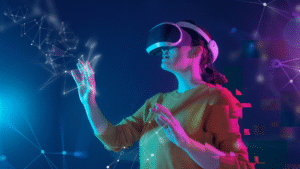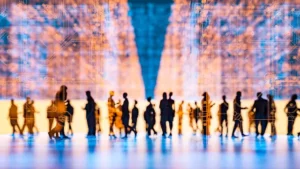Imagine stepping into a world where you can be anyone, go anywhere, and do anything—all from the comfort of your living room. The metaverse is no longer a sci-fi dream; it’s a vibrant, evolving network of virtual worlds reshaping how we connect, work, play, and learn. In this article, we’ll embark on a journey through the multifaceted metaverse, exploring its diverse applications, opportunities, and challenges. Whether you’re a curious newbie or a tech enthusiast, this guide will unravel the metaverse’s potential and show you how to dive in.
What Is the Metaverse? A Simple Breakdown
The metaverse is a collective of virtual, interconnected spaces where users interact through avatars, blending physical and digital realities. Think of it as a 3D internet powered by virtual reality (VR), augmented reality (AR), and artificial intelligence (AI). It’s not just one platform but a web of experiences, from gaming hubs like Roblox to virtual offices like Horizon Workrooms.
Why the Metaverse Matters
The metaverse matters because it redefines human interaction, offering immersive experiences that transcend geographical and physical limitations. It’s a space where you can attend a concert in a virtual stadium, collaborate with colleagues across continents, or explore ancient Rome—all in real time. Its growing popularity stems from its ability to merge creativity, technology, and community in ways we’re only beginning to understand.
The Evolution of the Metaverse: From Fiction to Reality
The term “metaverse” was coined by Neal Stephenson in his 1992 novel Snow Crash, where it described a virtual universe accessed through VR goggles. Fast-forward to today, and companies like Meta, Microsoft, and Epic Games are turning this vision into reality. The metaverse has evolved from niche gaming platforms like Second Life to a global phenomenon, driven by advancements in VR headsets, AI, and high-speed internet.
Key Milestones in Metaverse Development
The journey to today’s metaverse wasn’t overnight. It’s been shaped by technological leaps and cultural shifts:
- 2003: Second Life – One of the first platforms to offer a persistent virtual world for socializing and commerce.
- 2018: Fortnite – Blurred the lines between gaming and social spaces with in-game concerts and events.
- 2021: Meta’s Rebrand – Facebook’s shift to Meta signaled a corporate bet on the metaverse’s future.
- 2024: AI Integration – AI-driven avatars and environments made virtual worlds more dynamic and personalized.
The Role of Technology in Shaping the Metaverse
Technologies like VR, AR, and blockchain are the backbone of the metaverse. VR headsets like the Oculus Quest immerse users in 360-degree worlds, while AR overlays digital elements onto reality. Blockchain ensures secure digital ownership, letting users buy virtual land or collectibles as NFTs. Together, these tools create a seamless, interactive experience.
Diverse Virtual Worlds: Where the Metaverse Shines
The metaverse isn’t a monolith—it’s a tapestry of virtual worlds, each serving unique purposes. Let’s explore the key domains where the metaverse is making waves.
Gaming: The Heartbeat of the Metaverse
Gaming platforms like Roblox, Fortnite, and VRChat are the metaverse’s most accessible entry points. These worlds let millions create, play, and socialize in real time. For instance, Fortnite’s virtual concerts, like Travis Scott’s 2020 event, drew over 12 million attendees, showing the power of shared experiences.
Why Gaming Thrives in the Metaverse
Gaming in the metaverse offers unparalleled interactivity. Players can build their own worlds, trade virtual goods, and connect with friends globally. It’s not just about playing—it’s about creating and living in a digital ecosystem. Platforms like Roblox empower kids and adults alike to code their own games, fostering creativity.
Education: Learning Beyond the Classroom
The metaverse is revolutionizing education by offering immersive learning environments. Students can explore the pyramids in VR, conduct virtual science experiments, or attend global classrooms. A 2022 study found that metaverse-based learning increased student engagement by 30% compared to traditional methods.
Real Example: Medical Training in the Metaverse
In the UAE, universities are using the metaverse for medical training, allowing students to practice surgeries in virtual operating rooms. This hands-on approach bridges the gap between theory and practice, making learning more effective and accessible.
Work and Collaboration: The Virtual Office
The metaverse is redefining remote work. Platforms like Meta’s Horizon Workrooms let teams meet in virtual offices, complete with spatial audio and gesture tracking. Imagine brainstorming on a virtual whiteboard while your avatar mimics your real-world movements—it’s like Zoom on steroids.
Pros and Cons of Virtual Workspaces
| Pros | Cons |
|---|---|
| Global collaboration without travel | Requires expensive hardware (e.g., VR headsets) |
| Immersive, engaging meetings | Learning curve for non-tech-savvy users |
| Flexible, customizable environments | Potential for digital fatigue |
Social Spaces: Building Digital Communities
From virtual clubs to art galleries, the metaverse is a hub for social connection. Platforms like VRChat let users host events, from comedy nights to meditation sessions. I once attended a virtual book club in Decentraland, discussing Dune with people from five continents—it felt like a global campfire.
The Emotional Appeal of Virtual Socializing
There’s something magical about connecting with strangers in a virtual world. You’re not just a username; your avatar’s expressions and movements add a layer of humanity. It’s a reminder that even in digital spaces, we crave authentic connection.
Commerce and NFTs: The Metaverse Economy
The metaverse is a booming marketplace. Users buy virtual land, clothing, and art as NFTs, secured by blockchain. In 2021, a virtual plot in Decentraland sold for $2.4 million, showing the economic potential. Brands like Nike and Gucci are also launching virtual stores, blending fashion with digital identity.
Comparison: Traditional vs. Metaverse Commerce
| Aspect | Traditional Commerce | Metaverse Commerce |
|---|---|---|
| Accessibility | Physical stores, online websites | Virtual storefronts, open 24/7 |
| Experience | Limited by physical space | Immersive, customizable |
| Ownership | Physical goods | Digital assets (NFTs) |
| Reach | Local or regional | Global, instant |
Challenges and Ethical Considerations
The metaverse isn’t all rosy. It faces hurdles that could shape its future—or derail it.
Privacy and Security Concerns
Your avatar might feel free, but your data isn’t. The metaverse collects vast amounts of personal information, from eye movements to voice patterns. A 2023 study highlighted risks like data breaches and unauthorized tracking, urging robust privacy frameworks.
How to Stay Safe in the Metaverse
- Use strong, unique passwords for metaverse platforms.
- Avoid sharing sensitive personal details in virtual spaces.
- Opt for platforms with transparent privacy policies.
Accessibility and Equity
Not everyone can afford a $300 VR headset or a high-speed internet connection. This digital divide risks excluding low-income users, creating an elitist metaverse. Initiatives like Meta’s subsidized headsets aim to bridge this gap, but more work is needed.
Ethical Dilemmas
The metaverse raises questions about identity, addiction, and moderation. If you spend hours as a superhero avatar, does it affect your real-world self-esteem? And who polices virtual harassment? These are questions tech companies and policymakers are still grappling with.
Getting Started: How to Explore the Metaverse
Ready to dive in? The metaverse is more accessible than you think, with options for every budget and interest.
Best Tools and Platforms for Beginners
- Oculus Quest 2: Affordable VR headset for immersive experiences ($299).
- Roblox: Free, browser-based platform for gaming and socializing.
- Decentraland: Blockchain-based world for commerce and events (free to join).
- Horizon Workrooms: Meta’s virtual office space, ideal for remote workers.
Step-by-Step Guide to Your First Metaverse Experience
- Choose a Platform: Start with Roblox or VRChat for low-cost entry.
- Set Up Hardware: A smartphone or PC works for basic platforms; VR headsets enhance immersion.
- Create an Avatar: Customize your digital self to reflect your personality.
- Explore and Connect: Join events, games, or communities to get a feel for the space.
Where to Find Metaverse Communities
- Discord: Many metaverse platforms have active Discord servers for tips and events.
- Reddit: Subreddits like r/Metaverse offer user insights and recommendations.
- X Platform: Follow creators like @0xwitchy for metaverse trends and discussions.
The Future of the Metaverse: What’s Next?
The metaverse is still in its infancy, but its potential is staggering. By 2030, analysts predict it could be a $5 trillion market, impacting everything from healthcare to real estate. AI will make avatars smarter, while 6G networks will eliminate lag, creating seamless experiences. But the real question is: Will the metaverse unite us or deepen our digital divides?
Predictions for the Next Decade
- Education: Virtual classrooms will become standard, with 50% of universities adopting metaverse tools by 2030.
- Work: Hybrid offices will blend physical and virtual spaces, reducing commutes.
- Entertainment: Virtual concerts and sports will rival real-world events in popularity.
People Also Ask (PAA)
What is the metaverse in simple terms?
The metaverse is a network of virtual worlds where people interact as avatars, using VR, AR, or simple screens to work, play, or socialize. It’s like a 3D internet that feels alive and immersive.
Is the metaverse safe to use?
Safety depends on the platform and your precautions. Use strong passwords, avoid oversharing, and choose platforms with clear privacy policies to minimize risks like data breaches.
How can I access the metaverse for free?
You can access free platforms like Roblox or Decentraland using a smartphone or PC. No VR headset is required, though headsets enhance the experience.
What are the best metaverse platforms for gaming?
Roblox, Fortnite, and VRChat are top choices for gaming due to their vibrant communities, creative tools, and accessibility. Each offers unique worlds to explore and build.
Can the metaverse replace real-world interactions?
The metaverse enhances, not replaces, real-world interactions. It offers new ways to connect but can’t replicate the full depth of physical presence and human touch.
FAQ Section
How does the metaverse work?
The metaverse uses VR, AR, and AI to create immersive digital worlds. Users interact via avatars, accessing platforms through devices like headsets, PCs, or smartphones. Blockchain often secures digital assets.
Is the metaverse only for gamers?
No, the metaverse spans gaming, education, work, socializing, and commerce. While gaming is popular, platforms like Horizon Workrooms cater to professionals, and virtual classrooms serve students.
What equipment do I need for the metaverse?
Basic access requires a smartphone or PC. For full immersion, VR headsets like Oculus Quest 2 or high-end PCs with powerful GPUs are ideal but not mandatory.
Are there risks in the metaverse?
Yes, risks include privacy breaches, digital addiction, and accessibility issues. Always use secure platforms and be mindful of time spent in virtual spaces.
How can businesses benefit from the metaverse?
Businesses can use the metaverse for virtual stores, immersive marketing, or remote collaboration. Brands like Nike are already selling virtual products, tapping into a global audience.
Final Thoughts: Your Metaverse Adventure Awaits
The metaverse is a universe of possibilities, blending creativity, technology, and human connection. Whether you’re gaming with friends, learning in a virtual classroom, or building a digital empire, it offers something for everyone. But like any frontier, it comes with challenges—privacy, accessibility, and ethics demand our attention. So, grab your avatar, explore a virtual world, and join the journey. The metaverse isn’t just the future—it’s happening now, and you’re invited.
For more insights, check out Meta’s Horizon Workrooms or explore Roblox’s developer hub to start creating your own virtual world. What will your metaverse story be?







